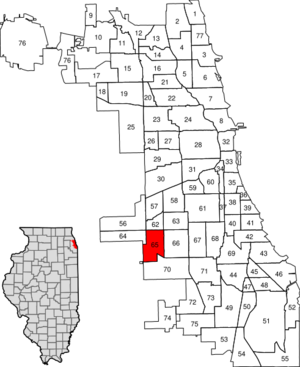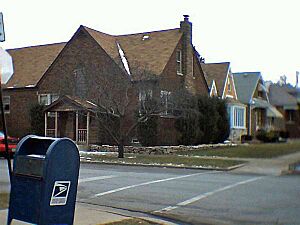West Lawn, Chicago facts for kids
Quick facts for kids
West Lawn
|
|
|---|---|
| Community Area 65 - West Lawn | |

Aerial view of West Lawn
|
|

Location within the city of Chicago
|
|
| Country | United States |
| State | Illinois |
| County | Cook |
| City | Chicago |
| Neighborhoods |
list
Ford City
West Lawn |
| Area | |
| • Total | 2.98 sq mi (7.72 km2) |
| Population
(2020)
|
|
| • Total | 33,662 |
| • Density | 11,293/sq mi (4,360.4/km2) |
| Demographics (2020) | |
| • White | 11.9% |
| • Black | 2.5% |
| • Hispanic | 85.1% |
| • Asian | 0.2% |
| • Other | 0.3% |
| Time zone | UTC-6 (CST) |
| • Summer (DST) | UTC-5 (CDT) |
| ZIP Codes |
part of 60629
|
| Median income 2020 | $54,758 |
| Source: U.S. Census, Record Information Services | |
West Lawn is one of Chicago's 77 official community areas. It is located on the southwest side of the city. West Lawn is known for its diverse population. Many different cultures and backgrounds come together here. It feels like a small town, even though it is part of a big city. Many Polish-Americans, Irish-Americans, and Mexican-Americans live in West Lawn. People from other parts of Latin America and Eastern Europe also call it home.
Contents
West Lawn's Past
Long ago, the land where West Lawn now stands was very wet and marshy. People settled in nearby areas like Chicago Lawn first. Some houses were built in West Lawn during the 1920s. But much of the land was still swampy.
More homes were built in the 1930s. At that time, many German-Americans, Irish-Americans, Polish-Americans, Czech-Americans, and Italian-Americans moved to the area. The community grew steadily until the Great Depression. This was a time when the economy became very bad.
After World War II, West Lawn started growing again. New houses and streets were built. In 1946, there were events called the Airport Homes race riots. During these events, some people tried to prevent Black families from moving into the area. After the 1970s, more Mexican-Americans, Irish-Americans, and Polish immigrants began to settle in West Lawn.
Important Places in West Lawn
West Lawn is home to the Balzekas Museum of Lithuanian Culture. You can find it on Pulaski Road. A Lithuanian-American businessman named Stanley Balzekas Jr. started this museum. It is the only museum in the United States focused on Lithuania. It teaches about the Lithuanian language, history, culture, and the experiences of Lithuanian-Americans.
There is also a unique small business in the neighborhood. It is the Capitol Cigar Store at 63rd and Pulaski. This store has a tall Native American statue outside. This statue is a well-known landmark in West Lawn. It was even seen in the movie Wayne's World.
Learning in West Lawn
Students in West Lawn attend schools that are part of the City of Chicago School District #299. For higher education, people can go to the City Colleges of Chicago District #508.
| Historical population | |||
|---|---|---|---|
| Census | Pop. | %± | |
| 1930 | 8,919 | — | |
| 1940 | 10,289 | 15.4% | |
| 1950 | 14,460 | 40.5% | |
| 1960 | 26,910 | 86.1% | |
| 1970 | 27,644 | 2.7% | |
| 1980 | 24,748 | −10.5% | |
| 1990 | 23,402 | −5.4% | |
| 2000 | 29,235 | 24.9% | |
| 2010 | 33,355 | 14.1% | |
| 2020 | 33,662 | 0.9% | |
Ford City Neighborhood
Ford City is a neighborhood located on the southwest side of Chicago. It is built around the Ford City Mall. The mall got its name from the Ford Aircraft plant that used to be there. This location was also home to the Dodge Chicago Plant. After World War II, the Tucker Car Corporation used it as a factory. In the future, the Orange Line of the Chicago "L" train system might be extended to this area.
Famous People from West Lawn
- Michael Madigan: He served as the 67th and 69th Speaker of the Illinois House of Representatives. He lives in West Lawn and represents the area in the Illinois House of Representatives.
- Frank Savickas: He was a member of the Illinois Senate from 1970 to 1992. He lived in West Lawn during his time in politics. Later, he moved to Venice, Florida.
- Leo Stefanos: He was the person who invented the famous DoveBar.


